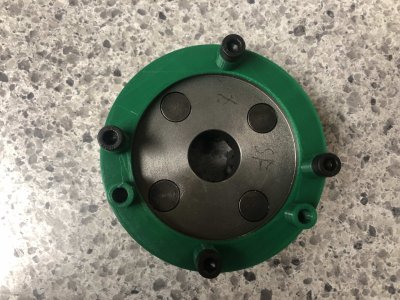Tomc938
Ultra Member
So I mentioned earlier that I got a four jaw chuck what for my Craftex B2227L lathe. The mounting plate is a great fit to the back of the chuck. Only issue is the church has 4 holes and the backing plate has 3. Thought I would share my solution, not because it is so great, but because it is a bit outside the box - and it worked great!
First thing I did was measure the outside diameter, and then the hole diameter. In Fusion 360 I designed and printed a guide with three equally distanced holes at that dimension. Super easy in Fusion. I printed a template 1.5 mm thick and checked it against the 3 jaw chuck. Perfect fit.
Then I measured the distance from one hole to the other (in Fusion) and thought I would us my callipers to lay out the holes from the one hole already there that would be used for mounting. Didn't work out so great. Then I had an idea - I could use Fusion to lay out FOUR holes just as easily as three, and if I started at the same hole for each bolt pattern I could make a template to screw to the back of the four jaw chuck and then use a transfer punch to mark the two new holes.
The transfer punch idea didn't quite go as planned. I would have needed a drill size "N" punch, which I don't have. (that's what happens when you work on the computer and pick any random size). So I used my N drill to line up the hole in my mill, and drilled and tapped each hole. Then onto the lathe!
In the spirit of Blondehacks who, unlike other youtubers, admits her mistakes, I should point out that I had inadvertently grabbed my 9 mm tap rather than the 8 mm one. Do you know ho hard it is to get a 9 mm cap head hex screw on Vancouver Island? Considered lots of options, and then decided to start from another of the 4 original holes in the chuck. Went a lot faster the second time round.
When I mounted it on my lathe everything fit! I can turn the screws in by hand. Put an indicator (cheap Chinese) on the chuck and ran pretty dang true even. We'll see how parallel it holds things in relation to the bed later.
Some pictures for your viewing pleasure. (PS: You can see the marking on the back that signifies either the chuck was build in San Fransisco, or some kid with the initials SF was in charge of QC. I also like the soft focus on the chuck on the lathe. The old girl deserves it!)
First thing I did was measure the outside diameter, and then the hole diameter. In Fusion 360 I designed and printed a guide with three equally distanced holes at that dimension. Super easy in Fusion. I printed a template 1.5 mm thick and checked it against the 3 jaw chuck. Perfect fit.
Then I measured the distance from one hole to the other (in Fusion) and thought I would us my callipers to lay out the holes from the one hole already there that would be used for mounting. Didn't work out so great. Then I had an idea - I could use Fusion to lay out FOUR holes just as easily as three, and if I started at the same hole for each bolt pattern I could make a template to screw to the back of the four jaw chuck and then use a transfer punch to mark the two new holes.
The transfer punch idea didn't quite go as planned. I would have needed a drill size "N" punch, which I don't have. (that's what happens when you work on the computer and pick any random size). So I used my N drill to line up the hole in my mill, and drilled and tapped each hole. Then onto the lathe!
In the spirit of Blondehacks who, unlike other youtubers, admits her mistakes, I should point out that I had inadvertently grabbed my 9 mm tap rather than the 8 mm one. Do you know ho hard it is to get a 9 mm cap head hex screw on Vancouver Island? Considered lots of options, and then decided to start from another of the 4 original holes in the chuck. Went a lot faster the second time round.
When I mounted it on my lathe everything fit! I can turn the screws in by hand. Put an indicator (cheap Chinese) on the chuck and ran pretty dang true even. We'll see how parallel it holds things in relation to the bed later.
Some pictures for your viewing pleasure. (PS: You can see the marking on the back that signifies either the chuck was build in San Fransisco, or some kid with the initials SF was in charge of QC. I also like the soft focus on the chuck on the lathe. The old girl deserves it!)



